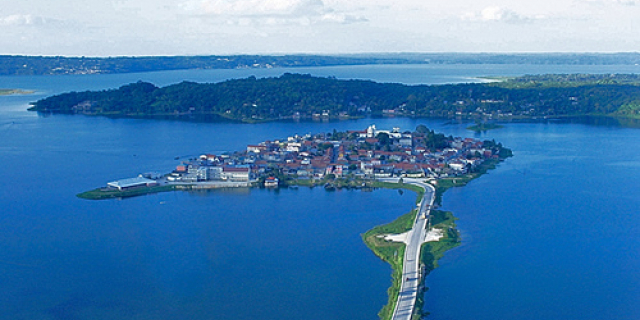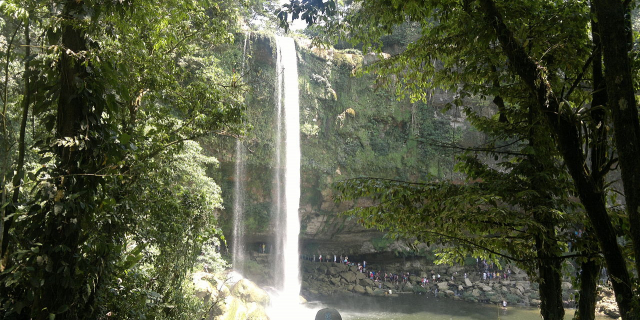Yaxchilán
( Yaxchilan )Yaxchilan (pronounced [ʝaʃtʃiˈlan]) is an ancient Maya city located on the bank of the Usumacinta River in the state of Chiapas, Mexico. In the Late Classic Period Yaxchilan was one of the most powerful Maya states along the course of the Usumacinta River, with Piedras Negras as its major rival. Architectural styles in subordinate sites in the Usumacinta region demonstrate clear differences that mark a clear boundary between the two kingdoms.
Yaxchilan was a large center, important throughout the Classic era, and the dominant power of the Usumacinta River area. It dominated such smaller sites as Bonampak, and had a long rivalry with Piedras Negras and at least for a time with Tikal; it was a rival of Palenque, with which Yaxchilan warred in 654.
The site is particularly known for its well-preserved sculptured stone lintels set above the doorways of the main structures. These lintels, together with the stelae erecte...Read more
Yaxchilan (pronounced [ʝaʃtʃiˈlan]) is an ancient Maya city located on the bank of the Usumacinta River in the state of Chiapas, Mexico. In the Late Classic Period Yaxchilan was one of the most powerful Maya states along the course of the Usumacinta River, with Piedras Negras as its major rival. Architectural styles in subordinate sites in the Usumacinta region demonstrate clear differences that mark a clear boundary between the two kingdoms.
Yaxchilan was a large center, important throughout the Classic era, and the dominant power of the Usumacinta River area. It dominated such smaller sites as Bonampak, and had a long rivalry with Piedras Negras and at least for a time with Tikal; it was a rival of Palenque, with which Yaxchilan warred in 654.
The site is particularly known for its well-preserved sculptured stone lintels set above the doorways of the main structures. These lintels, together with the stelae erected before the major buildings, contain hieroglyphic texts describing the dynastic history of the city.
 View of the Main Plaza at Yaxchilan
View of the Main Plaza at YaxchilanYaxchilan has its origins in the Preclassic Period.[1] A large part of what is known of the Classic Period history of the city comes from the hieroglyphic texts of the kings who ruled during its Late Classic apogee, one of the most important of which is Hieroglyphic Stairway 1.[2] Some retrospective inscriptions appear to have been used to rewrite Yaxchilan's dynastic history to suit king Bird Jaguar IV.[3] Before the rule of king Itzamnaaj Balam II, who reigned from 681 to 742, the city was relatively small.[3] The city-state then grew to a regional capital and the dynasty lasted into the early 9th century.
Early ClassicThe known history of Yaxchilan starts with the enthronement of Yopaat B'alam I, most likely on 23 July 359.[4] He was the founder of a long dynasty and took the throne when Yaxchilan was still a minor site.[3] Hieroglyphic inscriptions dating to the Late Classic describe a series of wars in the Early Classic between the city and its neighbors.[3] K'inich Tatb'u Skull I ruled in the early 5th century and was the first of the rulers of Yaxchilan to be recorded as having taken a rival king as a war captive, his prisoner being king Bird Jaguar of Bonampak (not to be confused with the four rulers of Yaxchilan who bore the same name).[5] The long-running rivalry with Piedras Negras had already begun by the fifth century AD, with both cities struggling to dominate the Usumacinta trade route.[3] King Moon Skull was credited with gaining a victory over Piedras Negras in 460 and with capturing the enemy king, known only as Ruler A.[3][5] By the middle of the 5th century Yaxchilan had formal contacts with the great city of Tikal.[6] Bird Jaguar II, the next king of Yaxchilan, captured a vassal of the king of Piedras Negras around 478.[3]
Knot-eye Jaguar I was a warlike king who was recorded as capturing nobles from Bonampak, Piedras Negras, and the great city of Tikal.[7] In 514, Knot-eye Jaguar I was taken captive by Ruler C of Piedras Negras, as depicted on Lintel 12 from that city, where he is shown kneeling before the enemy king with his wrists bound.[7][8]
His successor, K'inich Tatb'u Skull II, was enthroned on 11 February 526.[9] This king is notable for the series of carved lintels he commissioned, including a dynastic list that provides information on the early kings of the city.[9] K'inich Tatb'u Skull II oversaw a revival of Yaxchilan's fortunes, and he captured lords from Bonampak, Lakamtuun and, notably, the lord of Calakmul, one of the two great Maya powers of the Classic Period, as well as a success against Tikal, the second great power.[9]
Little is known of the history of Yaxchilan from 537 to 629, although four kings are known to have reigned in this period.[9] Knot-eye Jaguar II is known to have captured the lord of Lacanha in 564, one of the few events that can be identified from this period.[9] It may be that the lack of an inscribed history for this lengthy period indicates that Yaxchilan had fallen under the dominion of a more powerful neighbor, such as Piedras Negras Palenque or Toniná, all of which were powerful polities in the Usumacinta region at this time.[10]
Late ClassicThe Yaxchilano murals at Bonampak's Structure I commemorate Yaxchilan's appointment of Chan Muwaan I as subordinate ruler. Yaxchilan rebuilt the site to point back toward Yaxchilan.
In 629, Bird Jaguar III was enthroned as king of Yaxchilan.[11] In 646 or 647 he captured a lord from the still unidentified site of Hix Witz (meaning "Jaguar Hill"), somewhere on the north side of the Usumacinta.[11]
Yaxchilan reached its greatest power during the reigns of King Itzamnaaj B'alam II, who died in his 90s in 742, and his son Bird Jaguar IV.[12] Itzamnaaj B'alam II was enthroned in October 681 and he ruled for more than sixty years.[13] During the last third of his reign he was responsible for a monumental building programme that included the erection of magnificent buildings with richly carved lintels, hieroglyphic stairways and carved stelae, transforming the centre of the city.[13] During his reign, the kingdom of Yaxchilán extended to include the nearby sites of La Pasadita and El Chicozapote to the northwest of the city.[14] At times the sites of Lacanha and Bonampak appear to have been under his domination, although this region was controlled by Toniná in 715.[15]
In 689, relatively early in his reign, Itzamnaaj B'alam II is recorded as having captured Aj Sak Ichiy Pat.[16] In 713 he captured Aj K'an Usja, the ajaw, or lord, of B'uktunn, an otherwise unknown site.[16] In 726, Yaxchilan was defeated by its rival Piedras Negras, an event described on Piedras Negras Stela 8.[8] A sajal (subordinate lord) of Itzamnaaj B'alam II was captured by the enemy city, an event that is completely absent from inscriptions at Yaxchilán itself although, importantly, there is no false claim of victory.[17] It is after this period, over forty years into the reign of Itzamnaaj B'alam II, that this king embarked upon his impressive building programme, this may indicate that at this time Yaxchilan was able to exert independence from the hegemony of once powerful neighbours and claim greater political independence and more lucrative control of riverine trade.[13] In 729, Itzamnaaj B'alam II captured Aj Popol Chay, the lord of Lacanha.[16] This event, together with the other victories of Itzamnaaj Balam II's reign, is described both in the hieroglyphic texts of Structure 44 and also on a series of stelae near Structure 41.[16] This victory over Lacanha is compared to the earlier victory of Knot-eye Jaguar II against the same city.[16] Similarly, his capture of a lord of Hix Witz in 732 is compared to Bird Jaguar III's victory over the same site.[16]
In 749, Yopaat B'alam II of Yaxchilan attended a ceremony to honour Itzam K'an Ahk II of Piedras Negras.[18] If Yopaat B'alam II was king of Yaxchilan at this time, this would indicate that he was subordinate to the king of Piedras Negras.[19] This event was recorded on Piedras Negras Panel 3; there are no records of the reign of Yopaat B'alam II at Yaxchilan itself, indicating that any records were later destroyed if he had indeed ruled there.[19]
Yaxchilan retaliated in 759, gaining a victory over its enemy.[20] Circa 790 CE, Yaxchilan's king Shield Jaguar III oversaw the installation of Chan Muwaan II in Bonampak, and hired Yaxchilano artisans to commemorate it (and the previous Chan Muwaan) in "Structure I"'s murals.
In 808, king K'inich Tatb'u Skull III marked his capture of K'inich Yat Ahk II, the last king of Piedras Negras, an event that probably represented the final overthrow of Yaxchilan's long running enemy, ending dynastic rule there and destroying the city as a capital.[3]
Modern history Lintel 24, structure 23, Yaxchilan. The sculpture depicts a sacred blood-letting ritual which took place on October 28, 709.[21] King Itzamnaaj B'alam II is shown holding a torch, while his wife Lady K'ab'al Xook draws a barbed rope through her pierced tongue, British Museum.
Lintel 24, structure 23, Yaxchilan. The sculpture depicts a sacred blood-letting ritual which took place on October 28, 709.[21] King Itzamnaaj B'alam II is shown holding a torch, while his wife Lady K'ab'al Xook draws a barbed rope through her pierced tongue, British Museum.The first published mention of the site seems to have been a brief mention by Juan Galindo in 1833, published by the Royal Geographical Society.[22] Professor Edwin Rockstoh of the National College of Guatemala visited in 1881 and published another short account.[22]
Explorers Alfred Maudslay and Désiré Charnay arrived here within days of each other in 1882, and they published more detailed accounts of the ruins with drawings and photographs.[22] Maudslay ordered several lintels to be removed, and the British Museum acquired lintels 24 in 1932.[21] Maudslay's report was published by the Royal Geographical Society in 1883.[23] Teoberto Maler visited the site repeatedly from 1897 to 1900, his detailed two volume description of the ruins and other nearby sites was published by the Peabody Museum of Harvard University in 1903.[24][25]
In 1931 Sylvanus Morley led a Carnegie Institution expedition to Yaxchilan, mapped the site and discovered more monuments.
From 1970 onwards, Ian Graham made numerous visits to Yaxchilan and recorded the inscriptions there.[25] These inscriptions were published from 1977 onwards in the Corpus of Maya Hieroglyphic Inscriptions by the Peabody Museum of Harvard University.[25]
The Mexican National Institute of Anthropology and History (INAH) conducted archeological research at Yaxchilan in 1972–1973, again in 1983, and further INAH work was conducted in the early 1990s.[25] INAH has consolidated and preserved the central portion of the site.[24]
Mayanist Tatiana Proskouriakoff did some pioneering work on deciphering Maya writing using the inscriptions of Yaxchilan, and was able to identify the glyphs for death, capture and captor.[26] Since then Peter Mathews and others have expanded on her early work.[24]
Since 1990, the project La Pintura Mural Prehispánica en México (Prehispanic Wall Painting in Mexico) of the Instituto de Investigaciones Estéticas of the Universidad Nacional Autónoma de México has examined and recorded precolumbian murals such as those at Yaxchilan.
Yaxchilan has long been difficult to reach other than by river. Until recently, no roads existed within 100 miles. The only ways to get to the site were hundreds of miles by boat, or else by small plane. Since the construction of the Border Highway by the Mexican Government in the early 1980s, it is possible for tourists to visit. To reach the site, it is necessary now only to take an hour-long boat ride down the Usumacinta River from Frontera Corozal.
Some Lacandon Maya still make pilgrimages to Yaxchilan to carry out rituals to the Maya gods.[27]

































Add new comment